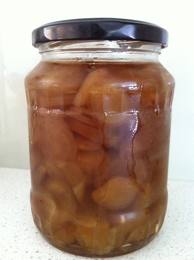Difference between revisions of "Ginger, preserved"
(Created page with "{{Infobox_Miscellaneous | image = Ginger_preserved,_Google,_images.jpg | origin = | stowage factor ...") |
|||
| Line 1: | Line 1: | ||
{{Infobox_Miscellaneous | {{Infobox_Miscellaneous | ||
| image = Ginger_preserved,_Google,_images.jpg | | image = Ginger_preserved,_Google,_images.jpg | ||
| − | | origin = | + | | origin = - |
| − | | stowage factor = | + | | stowage factor = - |
| − | | humidity and moisture = | + | | humidity and moisture = - |
| − | | ventilation = | + | | ventilation = - |
| − | | risk factors = | + | | risk factors = See text |
}} | }} | ||
| + | ==Description / Application== | ||
| + | Preserved ginger; a semi-liquid mixture of ginger root and syrup.<br><br> | ||
| + | Pickled ginger and preserved ginger are both forms that have been preserved in a [[brine]] of either sweet vinegar for the pickled version or sugar and [[salt]] for the preserved version. Pickled ginger is often served as an appetizer, while the pink pickled version is a common condiment for Japanese sushi, where it is referred to as gari. Preserved ginger is commonly used as a garnish for meats and fish, as a seasoning for desserts or candy, and as an ingredient in salads, sushi dishes, and specialty sandwiches.<br><br> | ||
| + | ==Shipment / Storage / Risk factors== | ||
| + | Often packed in jars inside cases and sometimes in casks. When shipped in casks some of the product may be absorbed giving a loss of weight on out-turn. This is usually allowed for in the filling. On account of possible leakage should be stowed clear of other sensitive cargoes, and in bottom tiers where drainage can be run clear. Leakage usually involves only the syrup, which is of far less value than the ginger itself, but if the ginger is not immersed it will deteriorate in quality. | ||
| + | |||
| + | [[Category: Products]][[Category: Food and beverages]] | ||
Latest revision as of 15:15, 24 June 2013
| Infobox on Ginger, preserved | |
|---|---|
| Example of Ginger, preserved |  |
| Facts | |
| Origin | - |
| Stowage factor (in m3/t) | - |
| Humidity / moisture | - |
| Ventilation | - |
| Risk factors | See text |
Ginger, preserved
Description / Application
Preserved ginger; a semi-liquid mixture of ginger root and syrup.
Pickled ginger and preserved ginger are both forms that have been preserved in a brine of either sweet vinegar for the pickled version or sugar and salt for the preserved version. Pickled ginger is often served as an appetizer, while the pink pickled version is a common condiment for Japanese sushi, where it is referred to as gari. Preserved ginger is commonly used as a garnish for meats and fish, as a seasoning for desserts or candy, and as an ingredient in salads, sushi dishes, and specialty sandwiches.
Shipment / Storage / Risk factors
Often packed in jars inside cases and sometimes in casks. When shipped in casks some of the product may be absorbed giving a loss of weight on out-turn. This is usually allowed for in the filling. On account of possible leakage should be stowed clear of other sensitive cargoes, and in bottom tiers where drainage can be run clear. Leakage usually involves only the syrup, which is of far less value than the ginger itself, but if the ginger is not immersed it will deteriorate in quality.











